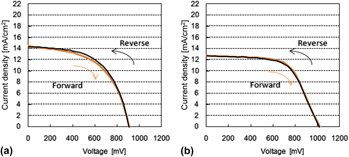Article contents
Effects of gas blowing condition on formation of mixed halide perovskite layer on organic scaffolds
Published online by Cambridge University Press: 13 July 2017
Abstract

Perovskite solar cells are promising for realizing high power conversion efficiency (PCE) with low manufacturing costs, but efficient coating methods are needed for commercialization. Here, a gas blowing method was used to fabricate perovskite solar cells and was found to create a smooth perovskite layer and to prevent voids in large-area cells, when organic materials were used as scaffolds for forming the perovskite. A PCE of 13% in a 1 cm2 active area is achieved by tuning the band-gap energy of MAPbX3 via substitution of Br for I ions in X sites. Incorporation of a poly(3,4-ethylenedioxythiophene) hole transport layer with a higher work function increased the open circuit voltage of the solar cells. All layers of the cells were fabricated at low temperatures (<140 °C), which makes it possible to incorporate a polymer substrate for producing flexible solar cells and high-throughput fabrication.
Keywords
- Type
- Invited Paper
- Information
- Copyright
- Copyright © Materials Research Society 2017
Footnotes
Contributing Editor: Sam Zhang
References
REFERENCES
- 5
- Cited by



